#Herodiade
Text
Herodiade




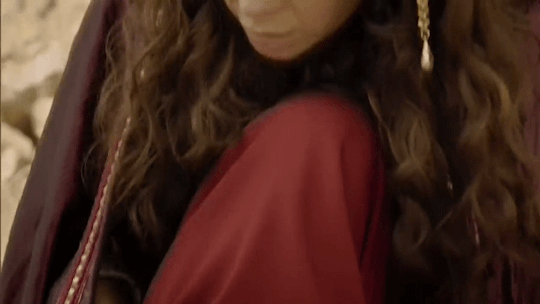
#history#Herodias#Herodiade#killer women#women in history#Women in the bible#Bible#biblical#Jesus#Novela#brazilian serie#brazilian actress
18 notes
·
View notes
Text

Charles G. Leland (Introduction by Raymond Buckland) - Aradia, The Gospel of the Witches - Buckland Museum - 1968
#witches#herodiades#occult#vintage#aradia#the gospel of the witches#gospel#buckland museum#charles g. leland#raymond buckland#new york#herodias#1968
21 notes
·
View notes
Link
0 notes
Text
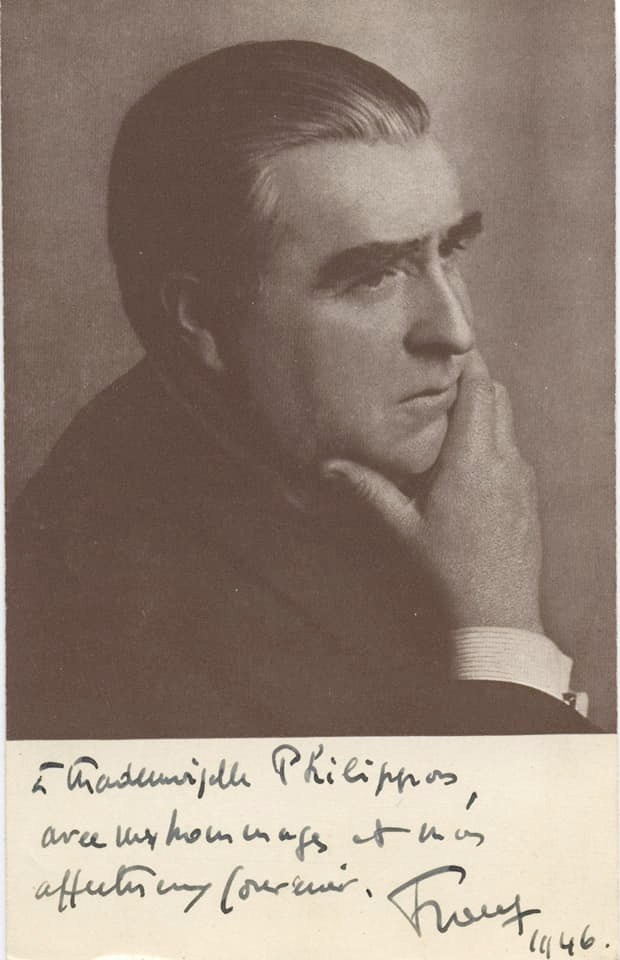
A Birthday salute to Paul Franz (1876-1950).
A very fine French tenor born in 1876 was Paul Franz, a direct successor to Affre and Escalis and France’s leading dramatic tenor.
He had a very unusual beginning because he was at 32 years of age, when he took first prize in a singing competition organised by a music magazine, which eventually secured him his operatic debut in Nau in Lohengrin, at the age of 33, a very late starter indeed.
Consider for example, that Anselmi had been singing for 13 years by the time he was 33. However, such was his initial success, that within a month, he had secured a contract at the Paris opera, for the same part as Lohengrin.
It was the beginning of an illustrious career at the opera, and in performances of Segued, Faust, Dan Houser, Sigmund, Radames and in particular, Samson & Delilah, he was often compared, not only to Affre but to Deresce himself, who had been idolised above all others at the Paris opera.
He first appeared in London in 1910 and despite strong competition from Dalmores in particular, he established himself at Covent Garden as leading French tenor until the war.
His debut was in Samson & Delilah, with Ruiz Courbellun, and he was to repeat his success in this opera during his Covent Garden seasons.
So, let’s hear him then, in his Covent Garden debut role of Samson in the aria Arêtes O Mes Freres.
In Paris, he had also become the leading vigneron interpreter in succession to Ernest van Dijk.
Making a great success in master singer, Tristan, and Siegfried and in 1913 he was the first pathe fal at the opera.
In addition, he received acclaim in other operas, such as Le Cede, Profit, Herodiade by Jeuive, the damnation of Faust, Helene, and the Trojans. As well as many contemporary works no longer in repertoire.
His fore’s abroad were not particularly frequent.
In 1915 he appeared at La Scala in Milan. Inevitably as Samson. And in 1918, he was at the Cologne in Buenos Aires.
In 1923 he was engaged by Ginzburg at the Monte Carlo opera to create a tenor lead in Ginzburgs own composition by Christopher. But from then on, he preferred to remain at his beloved Paris opera, where he made his farewell in 1938, at a benefit gala for the Paris Conservatoire.
Here he is in a beautiful version of the Flower Song from Carmen, where after some lovely opening phrases, the voice builds up to a splendid ringing climax.
He recorded for three companies, HMV, Pathe and Colombia. The selections already heard, were from HMV records. Choosing two final records, I suppose, I should have included a Wagner selection, because of his fame as a vigneron singer. But of course, he sings the items in French, and this never sounds right to me, no matter how well sung.
So I have chosen a French aria, Salut Tombeau from Romeo and Juliet and then a rare electrical Columbia record, made long after the HMV’s, when the singer was in his late 50s and still showing a marvelous voice and a wonderful feeling for the music, in an aria from Masani’s opera Herodiade which I hope you will recognise, as you heard it in the previous tape.
#classical music#opera#music history#bel canto#composer#classical composer#aria#classical studies#maestro#chest voice#Paul Franz#Franz#Conservatoire de Paris#l’Opéra de Paris#Heldentenor#Royal Opera House#Covent Garden#La Scala#classical musician#classical musicians#classical voice#classical history#musician#musicians#music education#music theory#history of music#tenor#dramatic tenor
1 note
·
View note
Text
José Carreras Massenet Herodiade Ne pouvant réprimer Barcelone 1984
youtube
0 notes
Text

Berthe Burgkan - Herodiade (1899)
52 notes
·
View notes
Photo

Henri Leopold Levy - Herodias (1872)
Musée des Beaux-Arts, Brest
#henri leopold levy#herodias#herodiade#french painter#oil on canvas#one thousand ophelias#salome#st john the baptist#biblical painting
111 notes
·
View notes
Photo

Cy Twombly
#cy twombly#herodiade#contemporary art#abstract#minimalism#fav#contemporary#art#drawings#drawing#pen
90 notes
·
View notes
Photo

1 note
·
View note
Photo

#filippolippi #herodiade #lefestindherode(détail) https://www.instagram.com/p/B_FZbhAhjeu/?igshid=1tcsqx1bcs5xm
0 notes
Photo

#Herodiade by www.m-d-art.com . #fineart #fineartphotography #vitrail #blonde #girl #model #angel #light #goddess #french #church #photography #glass #artisanat #clairobscur #dark #poetry #poesie #mallarme #correspondances #emotions #sensitive #beautifulbizarre @beautifulbizarre https://www.instagram.com/p/BuRlyyZHU-H/?utm_source=ig_tumblr_share&igshid=1elfijz2fx3ke
#herodiade#fineart#fineartphotography#vitrail#blonde#girl#model#angel#light#goddess#french#church#photography#glass#artisanat#clairobscur#dark#poetry#poesie#mallarme#correspondances#emotions#sensitive#beautifulbizarre
0 notes
Video
youtube
Gabriella Daleman’s Short Program at the World Championships 2017.
Acte IV Prelude from "Herodiade" by Jules Massenet
Scene XIV Ballet Finale from "Herodiade" by Jules Massenet
TS 39.19 + PS 33.00
Overall 72.19
Ranked 3rd. [Before FS]
#2017#skating#figure skating#figure skating 2017#canada#team canada#wsc#wsc2017#worlds#worlds 2017#world skating championships 2017#world skating championships#Ladies Singles#senior ladies#short program#Daleman#Gabriella Daleman#Acte IV Prelude from Herodiade#Herodiade#Scene XIV Ballet Finale from Herodiade#Scene XIV Ballet Finale#Act IV Prelude
1 note
·
View note
Text
The Italian form of the name Herodias is Erodiade. It appears that Herodias, the wife of Herod Antipas, in Christian mythology of the Early Middle Ages, came to be seen as a spirit condemned to wander the sky forever due to her part in the death of John the Baptist, permitted only to rest in treetops between midnight and dawn.
By the High Middle Ages, this figure seems to have become attached to the train of nymphs of Diana, now also seen as a host of spirits flying through the night across the Italian countryside. Other names attached to the night flight of Herodias included Minerva and Noctiluca.[5] The canon Episcopi is a passage from the work De ecclesiasticis disciplinis by Regino of Prüm (written ca. 906). It became notable as a paragraph of canon law dealing with witchcraft by the 12th century. Regino reports that there were groups of women who believed that they could go on night journeys where they would fly across the sky to meet Diana and her train. The name of Herodias is not present in the text as attributed to Regino, but in the version by Burchard of Worms, written ca. 1012, the reference to Diana (cum Diana paganorum dea) was augmented by "or with Herodias" (vel cum Herodiade).
Aradia is one of the principal figures in the American folklorist Charles Godfrey Leland's 1899 work Aradia, or the Gospel of the Witches, which he believed to be a genuine religious text used by a group of pagan witches in Tuscany, a claim that has subsequently been disputed by other folklorists and historians.[1] In Leland's Gospel, Aradia is portrayed as a messiah who was sent to Earth in order to teach the oppressed peasants how to perform witchcraft to use against the Roman Catholic Church and the upper classes.
... so cool...
14 notes
·
View notes
Text
Religious Medievalism: “Stregheria”, Wicca and History - part 2
[TN: thank you for the hearts and reblogs! I’m happy that you appreciate these translations! If sometimes they sound weird is because English is not my first language and the articles are written in proper, well phrased Italian, which makes it more difficult to translate.
I also want to reiterate that this article is a translation, synthesis and re-elaboration of the following articles
https://tradizioneitaliana.wordpress.com/2020/11/12/medievalismo-religioso-stregheria-wicca-e-storia/
https://medievaleggiando.it/la-legittimazione-storica-della-wicca-margaret-murray-e-la-manipolazione-delle-fonti/
https://medievaleggiando.it/il-vangelo-delle-streghe-e-linizio-della-wicca-il-fascino-di-un-falso-storico/
The first being a rectification of the two that follow.
Lastly, I lost this article two times. I had to rewrite the whole thing TWO TIMES. Imma take a well-deserved nap rn. Enjoy the reading, witches! ]
It’s correct to talk about pre-christian remainders that are confirmed by the trial’s documents. This remainders aren’t supposed to be considered as untouched, but as rielaborations influenced by the christian context; they are created in the Medieval age from previous remainders and, sometimes, even figures that were apart from the pre-existing Divinities, that emerged in the Medieval collective immagination to satisfy the needs that the Christianity wasn’t able to satisfy; an actual Medieval Pantheon of Spirits.
Historical sources (Burchard of Worms, William of Auvergne and many others) confirm the existence of food offerings to these entities. They were believed to go from home to home to consume the offering, dance, celebrate and bless the houses, followed by a Procession of female Spirits (Procession of the Dominae Nocturnae) or male Spirits (Wild Hunt/Procession of the Dead).
The existence of physical offerings demonstrates the effective existence of a cult of these new Medieval divinities, even if in a christian society and operated by people that probably defined themselves as christians.
A minority of people (that could sometimes even decide to waiver christianity, except for the social obligations) had ecstatic experiences of travel with said Procession of Spirits. In time, this legend was modified and altered, until it became the legend of the Ludus (Sabba), the celebrations that played out in one place and didn’t involve going from home to home; from then on the people that were having these experiences started reporting of going to the Ludus (Sabba) by flight.
In Europe’s Inner Dreams, Norman Cohn states that some of these people did truly dream of being Witches and to have partecipated to Ludus (Sabba) even though they never moved from their home.
From then on, we start referring to the Dream Cult of Witchcraft by affirming the presence of:
Legends of Witchcraft (Procession, Ludus (Sabba), etc)
Spirits tied to non-christian, medieval figures, similar to Gods
People that, influenced by those legends, experienced them in ecstatic / oniric fashion
Cohn states that the physical rite was rarely executed in the past and that it was consistently performed only in medieval and modern times, demonstrating the presence of a yearning to experiment altered states of consciousness, other realities, other worlds, and the will to interact with Spirits.
The Ludus (Sabba), happened mainly in somniis (in dream), but it could also be emulated in physical form, through a process called ostension; in this regard, Sabina Magliocco, professor of Anthropology and Religion at the University of British Columbia, writes:
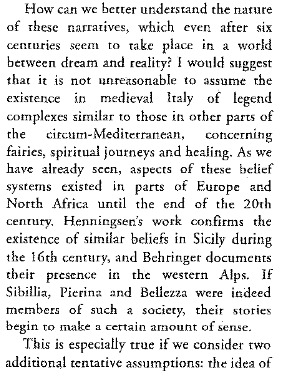

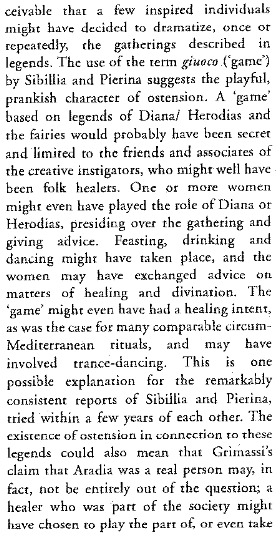
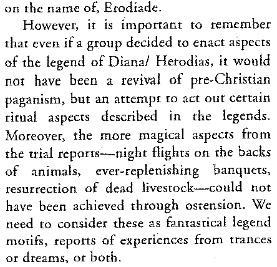
[Sabina Magliocco. Who Was Aradia? The History and Development of a Legend. Pomegranate: The Journal of Pagan Studies, vol. 18, 2002.]
LELAND’S GOSPEL OF ARADIA
Diana/Herodiade’s presence in tuscanian folklore as Spirits at the head of the Witches is attested long before Leland; in C15th BCE, the archbishop of Florence, Saint Antoninus of Florence while writing about popular beliefs reported:
“De quibusdam aliis superstitionibus, et primo de mulieribus credentibus se cum Diana vel Herodiade nocturnis horis equitare, vel se in alias creaturas transformari, ut dicitur de his, quae vulgariter dicuntur Streghe vel Ianutiche”.
[Giuseppe Bonomo. Caccia alle streghe. La credenza nelle streghe dal sec. XIII al XIX con particolare riferimento all’Italia. Palumbo Editore, 1985]
Sabina Magliocco demonstrated that similar variants of Aradia (Arada, Araja, Sa Rejusta, Redodesa, etc) existed in various regional folklores that referred to Herodias, so it’s probable that Aradia was an abbreviation or corruption of Herodias. Legends on Herodias and Diana that fly in the air at the head of the Witches are present in all of Europe, since Medieval times onward.
[Sabina Magliocco. “Aradia in Sardinia: the Archeology of a Folk Character”, in D. Green and D. Evans, ed., Ten Years of Triumph of the Moon: Essays in Honor of Ronald Hutton, 40–60. Bristol, UK: Hidden Publishing, 2009.]
[Sabina Magliocco. Who Was Aradia? The History and Development of a Legend. The Pomegranate: The Journal of Pagan Studies, Issue 18, Feb. 2002.]
We can also rule out that the Gospel was completely a fabrication from Leland, since the medievalist Robert Mathiesen proved by analizing the papers, that the Italian sections were almost untouched except for corrections of "precisely the sort that a proofreader would make as he compared his copy to the original".
[Robert Mathiesen, Charles G. Leland and the Witches of Italy: The Origin of Aradia, in Mario Pazzaglini (ed.), Aradia, or the Gospel of the Witches, A New Translation, Blaine, Washington, Phoenix Publishing, Inc., 1998.]
Mathiesen also demonstrated that the original Gospel was actually a lot smaller and that it has been filled with other material coming from folk tales and legends that he had previously gathered and wrote down in these volumes: “Etruscan Roman Remains in Popular Tradition” (1892), “Legends of Florence Collected From the People” (1896) and “Unpublished Legends of Virgil” (1899).
Probably, Maddalena only transcribed the folk legend of Diana/Aradia, that Leland then has assembled with many other legends that he had collected before.
In summary, there’s no universal Gospel of the Witches, no ancient text, but many legends that are probably ancient or re-elaborations deriving from an ancient substrate, since the theme of Diana/Herodiade as the heads of the Witches has medieval origins.
The presence of legends leads us to believe that someone did indeed put them in place, practicing ostensions: many people starting from tales and popular beliefs, tend to start emulating them. In a religious context, this means that probably there were believers in a cult that worshipped Diana, Aradia/Erodiade and Lucifer/Apollo, but it was NOT a giant alternative religious group or cults that were communicating with other cults that practiced the same faith in different places; they were merely spontaneous emulations of people that sometimes would gather with friends and relatives to emulate these legends.
Sources:
The following articles are the main source for the whole article, that is merely a translation and re-elaboration of them
https://tradizioneitaliana.wordpress.com/2020/11/12/medievalismo-religioso-stregheria-wicca-e-storia/
https://medievaleggiando.it/la-legittimazione-storica-della-wicca-margaret-murray-e-la-manipolazione-delle-fonti/
https://medievaleggiando.it/il-vangelo-delle-streghe-e-linizio-della-wicca-il-fascino-di-un-falso-storico/
[Giuseppe Bonomo. Caccia alle streghe. La credenza nelle streghe dal sec. XIII al XIX con particolare riferimento all’Italia. Palumbo Editore, 1985]
[Sabina Magliocco. “Aradia in Sardinia: the Archeology of a Folk Character”, in D. Green and D. Evans, ed., Ten Years of Triumph of the Moon: Essays in Honor of Ronald Hutton, 40–60. Bristol, UK: Hidden Publishing, 2009.]
[Sabina Magliocco. Who Was Aradia? The History and Development of a Legend. The Pomegranate: The Journal of Pagan Studies, Issue 18, Feb. 2002.]
[Robert Mathiesen, Charles G. Leland and the Witches of Italy: The Origin of Aradia, in Mario Pazzaglini (ed.), Aradia, or the Gospel of the Witches, A New Translation, Blaine, Washington, Phoenix Publishing, Inc., 1998.]
#witchcraft#italian witchcraft#traditional witchcraft#medieval witchcraft#witch#reconstructionist traditional witchcraft#wicca#aradia#diana#lucifer#apollo#stregoneria#stregheria#strega#streghe#spirits#gods#Familiars#gods and goddesses#pantheon#sabba#sabbat#ostension
125 notes
·
View notes

